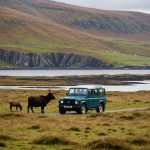Scotland, with its stunning landscapes and diverse wildlife, is a haven for nature enthusiasts. The country’s islands offer a unique blend of beautiful scenery, fascinating history, and abundant wildlife. While widely known islands like Skye and Orkney attract most visitors, there are several hidden gems that are equally enchanting. This article introduces you to those lesser-known islands, their unique wildlife offerings, and why they should be on your next holiday itinerary.
Mull: Hebrides’ Wildlife Capital
Mull, one of the lesser-known isles of the Hebrides, boasts a rich variety of wildlife in a stunning natural setting. From the sea eagles soaring in the sky to the red deer grazing across the landscape, Mull offers an all-encompassing wildlife experience.
En parallèle : What specific flora can you expect to see in the Welsh national parks during spring?
The island’s wide range of habitats makes it a thriving ground for various species. Its dramatic cliffs are home to bird species such as puffins and razorbills. The forests, on the other hand, provide shelter for otters and pine martens. The isle’s coastline is a hotspot for marine life with common sightings of seals, dolphins, and even whales.
Whether you prefer to explore on your own or with a guided tour, Mull will not disappoint. The island has several wildlife tour operators who provide a more structured approach to wildlife watching. Whichever way you choose to explore, Mull promises a memorable wildlife getaway.
Avez-vous vu cela : What are the recommended spots for a quiet reading retreat in the British countryside?
The Isle of Jura: Isolated Wilderness
The Isle of Jura, located to the left of mainland Scotland, is another hidden gem teeming with wildlife. Its isolation has preserved its natural beauty and wildlife, offering visitors an unspoiled island experience.
The island is home to a high concentration of red deer, with their numbers outnumbering the human population. Its diverse birdlife is also a major draw, with various species including golden eagles, buzzards, and numerous seabirds. Not to forget, the island’s waters are frequented by seals, otters, and dolphins.
The best time to visit Jura is between April and September when the wildlife is most active. For those looking for a more adventurous holiday, wild camping is permitted on the island. It’s a fantastic way to immerse yourself in the island’s wilderness and possibly spot some wildlife right from your tent.
Rum National Nature Reserve: Ecological Wonderland
The Isle of Rum, located at the bottom of the Hebrides chain, is a National Nature Reserve and offers a diverse range of habitats from moorland to mountainous terrain. It’s a perfectly preserved ecological wonderland.
Rum is a paradise for birdwatchers, with species such as the white-tailed eagle, golden eagle, and Manx shearwater. The island is also home to a unique herd of red deer, which have been the subject of a long-term scientific study due to their fascinating behavior.
Visitors to the island can immerse themselves in the wild landscape and watch wildlife by taking advantage of guided walks, Land Rover tours, and self-guided trails. The island also has a ranger service that offers weekly guided walks during the summer months.
Orkney’s Outer Isles: Unspoiled Beauty
While the main island of Orkney is a popular visitor destination, the archipelago’s outer isles remain largely less explored. These islands, such as Sanday, Stronsay, and Westray, provide a tranquil escape and a unique opportunity to connect with nature.
The outer isles are home to a variety of bird species, from puffins and arctic terns to curlews and lapwings. The islands’ coastlines see frequent visits from seals, while their white sandy beaches serve as nesting grounds for many seabirds.
To fully appreciate the wildlife and natural beauty of these islands, consider hiring a local guide. They can provide valuable insights into the best wildlife viewing spots and times, enhancing your visit.
Eigg: Self-sustaining and Biodiverse
The Isle of Eigg, located in the center of the Hebrides, is not just known for its unique community-driven, self-sustaining energy policy, but also its rich biodiversity. The island’s varied landscapes, from coastal cliffs to moorland and woodland, provide the perfect habitat for a variety of flora and fauna.
Visitors can spot a variety of bird species, including buzzards, ravens, and peregrine falcons. The isle’s waters are also home to marine life such as seals, dolphins, and minke whales.
Eigg offers a range of activities for wildlife lovers, from guided walks and birdwatching to marine life tours. The island’s commitment to sustainability and conservation makes it an ideal destination for eco-conscious travelers seeking a wildlife getaway.
Coll: The Birdwatcher’s Paradise
Coll, a true hidden gem in the Outer Hebrides, offers a peaceful retreat for lovers of nature and wildlife. This tranquil island has an unspoiled beauty that is impossible to resist, making it one of the best places to visit for a wildlife getaway.
Coll is renowned for its rich birdlife. The island is a designated Site of Special Scientific Interest and Special Area of Conservation due to its important bird populations. It hosts a vast variety of bird species starting from the Corncrake, for which it is most famous, to various seabirds and waterfowl species. The island’s rare machair habitat – a unique coastal grassland – is a haven for these birds, offering them the perfect breeding ground.
Being relatively flat, Coll is perfect for leisurely walks and cycling, allowing visitors to explore its diverse flora and fauna. Boat tours are also available, giving you a chance to witness the island’s marine life, including seals, dolphins, and occasional sightings of basking sharks and whales.
The island is not just for wildlife enthusiasts but also for those interested in history and culture. Ancient ruins, historic cemeteries, and the tranquil beauty of the Scottish Highlands make this island a place of unique charm.
Shetland Islands: A Blend of Scottish and Scandinavian Wilderness
Situated in the extreme north of Scotland, the Shetland Islands offer an exotic blend of Scottish and Scandinavian influences. The archipelago is renowned for its rugged landscapes, dramatic cliffs, and diverse wildlife, making it one of Scotland’s best places for a wildlife getaway.
The islands are home to an impressive array of bird species. The cliffs of Hermaness, a national nature reserve, host thousands of breeding seabirds including puffins, kittiwakes, guillemots, and the majestic gannet. Shetland is also the best place in the UK to see the elusive otter in its natural habitat.
The island group’s marine life is equally impressive. During a boat trip or sea kayaking adventure, you might spot seals, porpoises, orcas, and even minke whales in the surrounding waters.
Shetland’s rich cultural heritage, reflecting its Norse history, is an added bonus for visitors. The islands are home to several archaeological sites, including the well-preserved prehistoric village of Skara Brae.
Conclusion: Exploring Scotland’s Hidden Gems
Scotland is a treasure trove of wildlife, stunning landscapes, and vibrant culture. While the Isle of Skye and Inner Hebrides are undoubtedly beautiful, the lesser-known islands offer equally enchanting experiences with less tourist traffic.
Whether you’re a solo explorer or are looking for a small group adventure, these hidden gems of Scotland offer the perfect combination of solitude and natural beauty. Each island, with its unique wildlife, captivating history, and diverse landscape, promises a different experience.
A visit to these less explored Scottish islands is not just a day trip but an opportunity to immerse yourself in the natural beauty and wilderness walking through the Scottish Highlands. So, pack your binoculars, don your walking boots, and prepare for a wildlife getaway that will stay with you long after you leave these rugged shores.






